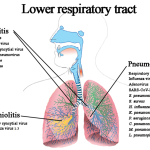The Revealing Truth: Unveiling The Impact Of Routine Respiratory Flora Heavy Growth – Act Now!
Routine Respiratory Flora Heavy Growth: Understanding the Importance and Implications
Introduction
Welcome, plant lover! Today, we delve into the fascinating world of routine respiratory flora heavy growth. In this article, we will explore what it is, who it affects, when and where it occurs, why it is significant, and how it can be managed. Let’s embark on this informative journey together!
2 Picture Gallery: The Revealing Truth: Unveiling The Impact Of Routine Respiratory Flora Heavy Growth – Act Now!


What is Routine Respiratory Flora Heavy Growth?
🌿 Routine respiratory flora heavy growth refers to the excessive proliferation of microorganisms in the respiratory tract. These microorganisms include bacteria, fungi, and other flora that are normally present but have multiplied beyond the expected levels. This condition can be detected through various laboratory tests that examine respiratory samples.
Who Does Routine Respiratory Flora Heavy Growth Affect?

Image Source: mdpi.com
🌿 Routine respiratory flora heavy growth can affect individuals of all ages, from infants to the elderly. It is commonly observed in individuals with compromised immune systems, chronic respiratory conditions, or those who have recently undergone invasive respiratory procedures. Additionally, people in close contact with infected individuals or living in crowded environments are also at higher risk.
When and Where Does Routine Respiratory Flora Heavy Growth Occur?
🌿 Routine respiratory flora heavy growth can occur at any time when conditions are conducive for microbial proliferation. It particularly thrives in environments with poor air circulation, high humidity, and low ventilation. Common locations where heavy growth can occur include hospitals, nursing homes, daycare centers, and other crowded places.
Why is Routine Respiratory Flora Heavy Growth Significant?

Image Source: springernature.com
🌿 Routine respiratory flora heavy growth is significant due to its association with respiratory infections and other health complications. When the microbial balance in the respiratory tract is disrupted, it can lead to the development of respiratory tract infections, pneumonia, bronchitis, and other respiratory illnesses. Moreover, heavy growth can contribute to antibiotic resistance, making treatment more challenging.
How Can Routine Respiratory Flora Heavy Growth be Managed?
🌿 Managing routine respiratory flora heavy growth involves several strategies. These include proper hand hygiene, regular disinfection of surfaces, adequate ventilation, and maintaining a clean and healthy environment. Additionally, it is crucial to identify and address any underlying medical conditions that may predispose individuals to heavy growth. In some cases, targeted antimicrobial therapy may be required to control the excessive proliferation of microorganisms.
Advantages and Disadvantages of Routine Respiratory Flora Heavy Growth
🌿 Understanding the advantages and disadvantages of routine respiratory flora heavy growth can provide insights into the implications it has on individuals and healthcare systems.
Advantages of Routine Respiratory Flora Heavy Growth
🌿 1. Early Detection: Routine respiratory flora heavy growth can serve as an indicator of an underlying respiratory infection or compromised immune system, allowing for timely intervention and treatment.
🌿 2. Research Opportunities: Studying heavy growth patterns can provide valuable insights into the microbial ecology of the respiratory tract and aid in the development of targeted therapies.
🌿 3. Infection Control Measures: Identifying heavy growth can prompt the implementation of infection control measures to prevent the spread of respiratory infections in healthcare settings and communities.
Disadvantages of Routine Respiratory Flora Heavy Growth
🌿 1. Increased Disease Burden: Heavy growth can lead to more severe and recurrent respiratory infections, increasing the burden on healthcare systems and potentially compromising patient outcomes.
🌿 2. Antibiotic Resistance: The excessive proliferation of microorganisms in heavy growth can contribute to the development of antibiotic resistance, making treatment less effective and more challenging.
🌿 3. Complications in Vulnerable Populations: Individuals with weakened immune systems or underlying respiratory conditions may experience more severe complications and longer recovery periods due to heavy growth.
Frequently Asked Questions (FAQ)
1. Can routine respiratory flora heavy growth be prevented?
Yes, routine respiratory flora heavy growth can be prevented through proper hygiene practices, maintaining a clean environment, and addressing any underlying medical conditions.
2. What are the symptoms of routine respiratory flora heavy growth?
Routine respiratory flora heavy growth itself may not present specific symptoms. However, it can contribute to respiratory infections that may cause symptoms such as cough, fever, chest discomfort, and difficulty breathing.
3. Are there any home remedies for managing routine respiratory flora heavy growth?
While home remedies cannot directly address heavy growth, maintaining a healthy lifestyle, including regular exercise, a balanced diet, and adequate rest, can support overall respiratory health.
4. Is routine respiratory flora heavy growth contagious?
Routine respiratory flora heavy growth is not contagious itself. However, heavy growth can increase the risk of respiratory infections, which may spread from person to person through respiratory droplets.
5. How is routine respiratory flora heavy growth diagnosed?
Routine respiratory flora heavy growth can be diagnosed through laboratory tests that analyze respiratory samples, such as sputum cultures or bronchoalveolar lavage.
Conclusion
In conclusion, routine respiratory flora heavy growth is a condition characterized by the excessive proliferation of microorganisms in the respiratory tract. While it can pose challenges and risks, understanding its implications and implementing appropriate management strategies can help mitigate its impact. By prioritizing hygiene, maintaining a clean environment, and addressing underlying medical conditions, we can strive towards healthier respiratory systems and improved overall well-being.
Final Remarks
🌿 It is important to note that the information provided in this article is for educational purposes only and should not replace professional medical advice. If you have any concerns or questions regarding routine respiratory flora heavy growth or any respiratory condition, it is recommended to consult a healthcare professional for personalized guidance and treatment.
This post topic: Flora
